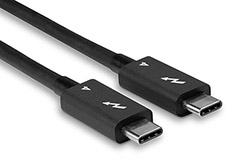Thunderbolt is a connection technology for transferring both image and data signals in one and the same cable. Over time, the Thunderbolt standard has evolved from using connectors of the same type as Mini Displayport (Thunderbolt 1 and 2) to now having USB-C connectors (Thunderbolt 3 and newer).
The big advantage of Thunderbolt connections is that you can connect a Thunderbolt docking station/hub or monitor with just a single cable. For example at the fixed workstation for the laptop, where the fixed connections to peripheral devices (screen, keyboard, network, etc.) are connected to the dock. This is the same as with USB-C hubs and docking stations.
Cables for the Thunderbolt 3 protocol with USB-C connector, typically for connecting a monitor. Thunderbolt version 3 handles speeds up to 40 Gbps (5 GB/sec) and supports 4K 120 Hz or 5K at 60 Hz.
Cables for the Thunderbolt 4 protocol with USB-C connector, typically for connecting a monitor. Thunderbolt 4 handles speeds up to 40 Gbps (5 GB/sec) and supports two 4K displays or one 8K at 60 Hz.
Thunderbolt 1 and 2 use Mini Displayport connectors, but note the general. Mini DP cables cannot be used for connecting Thunderbolt, as it requires special electronics in the connectors and cable certification.
Thunderbolt 3 and 4 connections, like
USB4, use only USB-C connectors. The reason why only USB-C connectors can be used and not the other different versions of USB (USB-A and USB-B connectors) is that they cannot handle the amount of data required by the Thunderbolt 4 specification. Likewise, here it is required that the cables are certified for Thunderbolt in a given version before they can be used for the purpose.

